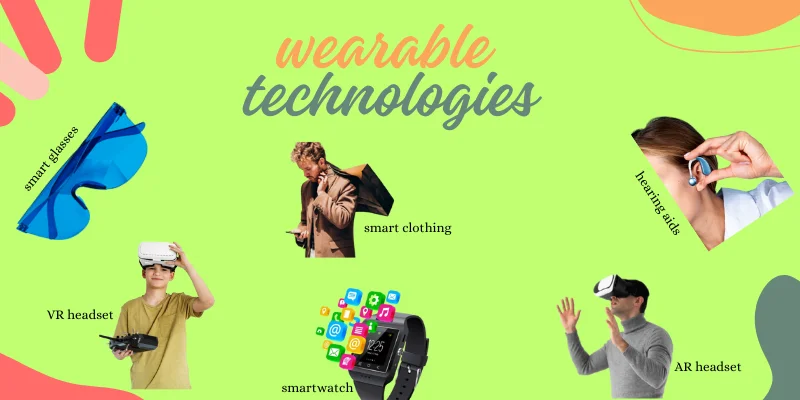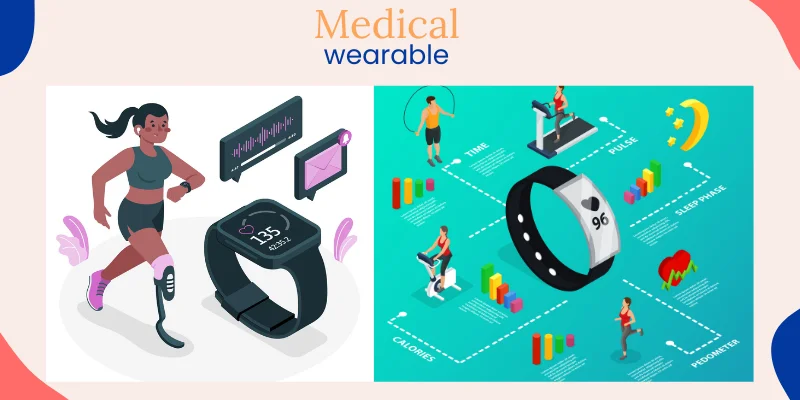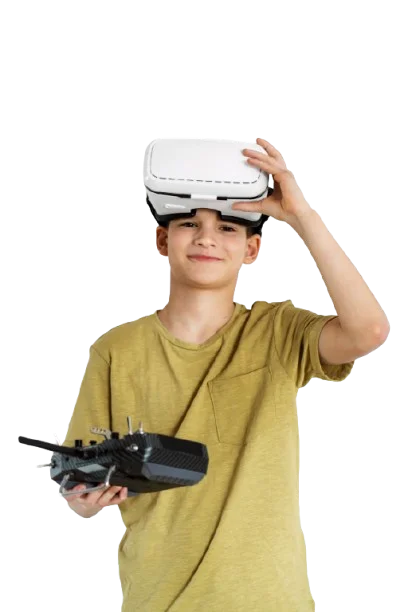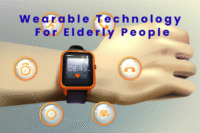Explore the Various Types of Wearable Technology and Their Uses
Published: 09 Sep 2025
Different types of wearable technology are making life easier, healthier, and more exciting. Modern wearable technology has transformed how we track health, fitness, and communication.
Each type of wearable has its own special use. Knowing about them can help you pick the right one for your lifestyle and goals.

Here’s a quick list of the different types of wearable technology:
- Smartwatches
- Fitness trackers
- Smart glasses
- Smart clothing
- Hearing aids
- Medical wearables
- Virtual reality (VR) headsets
- Augmented reality (AR) headsets
- Smart rings
Now we will discuss each type of wearable technology in more detail.
What is a Smartwatch?
These are wrist-worn devices that combine the functions of a traditional watch with smart features like health monitoring and connectivity.
A smartwatch is a wearable device designed to go beyond just telling time. It works like a mini-computer on your wrist, offering features like notifications, apps, and fitness tracking.
Key Features of Smartwatches
Smartwatches make life easier by keeping everything close to your wrist. From health tracking to checking messages, they save time and add comfort to daily routines.
- Touchscreen interface
- Notifications for calls, messages, and apps
- Fitness tracking (e.g., steps, heart rate, calories burned)
- GPS and navigation
- Compatibility with smartphones
- Customizable watch faces and straps
Common Uses for Smartwatches
From setting alarms to tracking steps, smartwatches are useful in many ways. They save time and bring important updates right to your wrist.
- Staying connected with notifications and calls
- Tracking fitness and health goals
- Managing daily schedules with reminders and alarms
- Monitoring health metrics like heart rate and sleep patterns
- Using apps for productivity and entertainment
Popular Examples of Smartwatches
There are many wearable devices examples but here we just show the smartwatches:
- Apple Watch Series
- Samsung Galaxy Watch
- Fitbit Versa
- Garmin Fenix
- Fossil Gen Smartwatches
Benefits of Smartwatches
Smartwatches make life more convenient by keeping health, time, and notifications in one place. They save time and keep you updated anywhere. Smartwatches benefits include:
- Helping users stay organized with reminders and notifications
- Promoting fitness with activity tracking features
- Enhancing convenience by providing quick access to apps and messages
- Monitoring health in real-time
Future Potential of Smartwatches
The future of smartwatches health looks promising. Advanced sensors and AI could help predict health issues and offer personalized health insights. As technology evolves, smartwatches may become even more essential in healthcare and everyday life. If you want to know which companies are leading this market? Read our article on the Top 10 Wearable Technology Companies.
What is a Fitness Tracker?
A fitness tracker is a wearable device designed to monitor physical activities and health metrics. It’s like a digital coach on your wrist, helping you track your progress and stay motivated. These devices focus on health and fitness, providing real-time data to improve your well-being.
Key Features of Fitness Trackers
With features like calorie counting and workout tracking, fitness trackers act as a personal coach on your wrist.
- Step counting and distance tracking
- Calorie burn estimation
- Heart rate monitoring
- Sleep tracking and analysis
- Waterproofing for swim tracking (in some models)
- Integration with fitness apps
Common Uses for Fitness Trackers
Many users wear them daily to set fitness goals, follow routines, and build healthier lifestyle habits.
- Tracking daily steps and physical activity levels
- Monitoring sleep patterns for better rest
- Measuring heart rate during workouts
- Encouraging users to stay active with reminders and goals
- Logging workout sessions and tracking progress
Popular Examples of Fitness Trackers
From budget-friendly Mi Band to premium Fitbit Charge, there is a fitness tracker for every need and budget.
- Fitbit Charge Series
- Garmin Vivosmart
- Xiaomi Mi Band
- Amazfit Bands
- Whoop Strap
Benefits of Fitness Trackers
These devices remind you to move, track your sleep, and support healthier habits. They make fitness goals easier to achieve. Fitness trackers offer many benefits, including:
- Encouraging a more active lifestyle by setting and tracking goals
- Providing valuable health insights like heart rate trends and sleep quality
- Helping users stay consistent with exercise routines
- Offering motivation through achievements and reminders
Fitness Trackers in Daily Life
Fitness trackers have become essential for people wanting to improve their physical and mental health. Whether it’s tracking steps during a walk, analyzing sleep quality, or measuring workout intensity, these devices help users stay informed about their well-being.
Future Potential of Fitness Trackers
Fitness trackers are constantly improving, with advancements like more accurate sensors, better integration with medical data, and AI-driven health insights. In the future, they may provide even deeper health analysis, helping users prevent health issues before they arise.
What are Smart Glasses?
Smart glasses are wearable devices that combine the functionality of regular eyeglasses with advanced digital technology. They are designed to display information, capture visuals, or enhance the world around you using augmented reality (AR). These glasses make everyday tasks smarter and more interactive by projecting data directly into your field of view.
Key Features of Smart Glasses
These glasses often include voice control, cameras, and augmented reality features. They make daily tasks hands-free and smarter.
- Built-in display or projection system
- Augmented reality (AR) overlays for real-world interaction
- Hands-free voice control
- Built-in cameras for photos and videos
- Connectivity via Bluetooth or Wi-Fi
- Lightweight and stylish designs
Common Uses for Smart Glasses
They are also used in workplaces for training, remote help, and real-time data sharing, making tasks faster and easier.
- Viewing notifications and information without looking at a screen
- Navigating with real-time maps and directions
- Capturing hands-free photos or videos
- Enhancing work productivity through AR in industries like construction and healthcare
- Playing AR-based games and interactive activities
Popular Examples of Smart Glasses
Each of these brings unique features like AR display, voice control, or built-in cameras for daily use and work.
- Google Glass
- Microsoft HoloLens
- Snap Spectacles
- Ray-Ban Stories (by Facebook and Ray-Ban)
- Vuzix Blade
Benefits of Smart Glasses
Smart glasses make life easier by showing information right in front of your eyes without using your phone. Smart glasses provide several advantages:
- Offering a hands-free way to access information
- Improving productivity in professional settings
- Enhancing gaming and entertainment experiences with AR
- Allowing discreet communication and notifications
- Supporting visually impaired users with navigation aids
Smart Glasses in Everyday Life
Smart glasses are becoming increasingly useful in daily life. From helping professionals visualize data on the go to providing immersive gaming experiences, these devices are versatile. They’re also helpful for people who need hands-free access to information while working or traveling.
Future Potential of Smart Glasses
The future of smart glasses looks promising as AR and AI technologies continue to evolve. Upcoming advancements could include more immersive AR experiences, better integration with smart home systems, and enhanced tools for accessibility. They may even replace traditional screens, making them an integral part of wearable technology.
What is Smart Clothing?
Smart clothing refers to wearable garments that are embedded with advanced technology to monitor, enhance, or improve the wearer’s performance and health. These clothes integrate sensors, electronics, and fabrics to offer features beyond regular clothing, blending fashion with functionality.
Key Features of Smart Clothing
Smart clothing combines fashion with technology to make everyday wear more useful. These clothes do more than look good — they track health, boost comfort, and connect with smart devices.
- Embedded sensors to track physical activity and health metrics
- Temperature regulation features for comfort
- Connectivity with smartphones or other devices
- Real-time data collection and analysis
- Lightweight and washable designs
Common Uses for Smart Clothing
Smart clothing is not just about style — it’s built to make life easier and smarter. People use it for health, fitness, safety, and even work. Here are some common uses:
- Monitoring heart rate, breathing, and muscle activity during workouts
- Helping athletes improve performance with detailed movement tracking
- Providing heated or cooling options for outdoor activities
- Assisting healthcare professionals in monitoring patients remotely
- Enhancing safety with features like fall detection or stress monitoring
Popular Examples of Smart Clothing
Smart clothing is already part of real life, not just a future idea. Many big brands and startups are creating clothes with built-in technology. Here are some well-known examples:
- Hexoskin Smart Shirts
- Athos Training Gear
- Nadi X Yoga Pants
- Levi’s Commuter Jacket with Google Jacquard
- Sensoria Smart Socks
Benefits of Smart Clothing
Smart clothing offers several advantages:
- Helps individuals stay active and track their fitness goals
- Provides health insights for better lifestyle choices
- Supports athletes with detailed performance metrics
- Improves comfort and safety in harsh conditions
- Bridges the gap between fashion and technology
Smart Clothing in Everyday Life
Smart clothing is gradually becoming a part of daily life, offering unique features like monitoring health, improving fitness, and providing enhanced comfort. From gym workouts to healthcare monitoring, these garments are versatile and innovative.
Future Potential of Smart Clothing
The future of smart clothing is exciting, with advancements like self-healing fabrics, better durability, and even more precise health monitoring. As wearable technology evolves, smart clothing could become a staple in fitness, healthcare, and everyday fashion.
What are Hearing Aids?
Hearing aids are small wearable devices designed to improve hearing for individuals with hearing loss. These devices amplify sound, making it easier for the wearer to hear and communicate in different environments. Modern hearing aids also include smart features, making them part of the growing world of wearable technology.
Key Features of Hearing Aids
Modern hearing aids are small but powerful devices designed to improve hearing and communication. They offer comfort, clarity, and smart functions that fit different lifestyles. Here are the key features:
- Sound amplification tailored to the user’s needs
- Noise reduction for clearer audio in noisy environments
- Bluetooth connectivity for pairing with smartphones and other devices
- Rechargeable batteries for convenience
- Discreet, lightweight designs for comfort
- Help to reduce ringing in the ears (tinnitus).
Common Uses for Hearing Aids
Hearing aids are more than just sound boosters. They help people stay connected, safe, and confident in daily life. Here are the common uses:
- Helping individuals with hearing loss improve their ability to hear speech and sounds
- Connecting to devices for streaming phone calls, music, or TV audio
- Enhancing communication in noisy or crowded settings
- Supporting better hearing in various environments, such as work or social gatherings
Popular Examples of Hearing Aids
Today’s hearing aids come from trusted brands that mix technology with comfort. They are designed to improve hearing while fitting into everyday life. Here are some popular examples:
- Phonak Audéo Paradise
- Oticon More
- Widex Moment
- ReSound One
- Signia Pure Charge & Go
Benefits of Hearing Aids
Hearing aids offer several benefits, including:
- Improved hearing and communication in daily life
- Enhanced quality of life through better sound clarity
- Connectivity to modern devices for added convenience
- Customizable settings to match different environments
- Assistance with managing tinnitus or other hearing-related conditions
Hearing Aids in Everyday Life
Hearing aids play a vital role in improving the lives of those with hearing challenges. They not only restore the ability to hear but also provide features like streaming music or phone calls, making them practical for modern lifestyles.
Future Potential of Hearing Aids
The future of hearing aids is promising, with advancements in AI, better sound processing, and more integration with wearable tech. Innovations may include more precise customization, real-time health monitoring, and even translation capabilities, further improving accessibility and convenience.
What is a medical wearable?
A medical wearable is a device that people wear to monitor their health. There are many types of wearable medical devices that are used to track vital signs and provide real-time health data. They are often used to manage long-term illnesses or improve overall health awareness.
How does a medical wearable work?
Medical wearables use built-in sensors to collect data like heart rate, blood pressure, or glucose levels. This data is then sent to connected apps or medical platforms through Bluetooth or Wi-Fi. Some devices also alert users or healthcare providers when readings are abnormal.

Key features of medical wearables
Medical wearables are smart devices people can wear to track health in real time. They help patients, doctors, and caregivers stay updated about health conditions. Here are the key features:
- Sensors for tracking health metrics like heart rate, oxygen levels, and glucose.
- Real-time data sharing with smartphones or medical systems.
- Alerts for irregular health patterns or emergencies.
- Lightweight, comfortable designs for all-day wear.
Applications of medical wearables
Medical wearables are changing how people manage health. They are used at home, in hospitals, and even during daily activities. Here are the main applications:
- Chronic disease management: Helps monitor conditions like diabetes and heart disease.
- Remote patient care: Enables doctors to monitor patients from a distance.
- Fitness and recovery: Tracks physical activity and recovery after surgeries.
- Early health warnings: Identifies potential health risks early.
Benefits of medical wearables
Medical wearables make healthcare simple, smart, and more personal. They give both patients and doctors useful information to improve health outcomes. Here are the key benefits:
- Encourages proactive health management.
- Provides continuous monitoring for better insights.
- Helps doctors make faster, data-driven decisions.
- Reduces hospital visits through remote monitoring.
Challenges or limitations of medical wearables
While medical wearables offer many benefits, they also face some challenges. These issues affect how well they work for patients, doctors, and the healthcare system. Here are the main limitations:
- Data accuracy may not always be reliable.
- High device costs make them less accessible to some users.
- Privacy concerns due to sensitive health data being shared or stored.
- Limited battery life can require frequent charging.
Popular examples of medical wearables
Here are some wearable technology examples:
- Continuous glucose monitors like FreeStyle Libre and Dexcom.
- Smartwatches with ECG capabilities, such as the Apple Watch.
- Wearable blood pressure monitors like Omron HeartGuide.
- Fitness trackers with advanced health sensors like Fitbit Sense.
What is a virtual reality (VR) headset?
A virtual reality (VR) headset is a wearable device that immerses users in a digital world. By putting it on, you can experience 3D environments and interact with them as if you were physically present.
How does a virtual reality (VR) headset work?
VR headsets use lenses, sensors, and screens to create realistic visuals. They track your head movements and adjust the display to make the virtual environment

Virtual Reality (VR) Headset
Key features of virtual reality (VR) headsets
VR headsets bring digital worlds to life, making users feel as if they are inside the experience. They combine visuals, sound, and motion to create full immersion. Here are the key features:
- High-resolution displays for realistic visuals.
- Motion tracking for head and body movements.
- Controllers or hand sensors for interaction.
- Built-in speakers for 3D sound effects.
- Compatibility with VR apps and games.
Applications of virtual reality (VR) headsets
VR headsets are no longer just for gamers — they are used in many fields to make learning, training, and entertainment more engaging. Here are the main applications:
- Gaming: Immersive gaming experiences that put players in the middle of the action.
- Education: Virtual classrooms and interactive learning simulations.
- Healthcare: Training for medical procedures or therapeutic use for patients.
- Training: Simulations for pilots, drivers, and military personnel.
- Entertainment: Virtual tours, concerts, and movies in 360-degree views.
As reported by Statista, the VR market is growing rapidly and is expected to transform industries beyond gaming
Benefits of virtual reality (VR) headsets
VR headsets bring powerful advantages by combining fun, learning, and real-world problem-solving. They create experiences that are engaging and effective. Here are the key benefits:
- Provides immersive experiences for entertainment or education.
- Enhances training with realistic simulations.
- Helps in medical and mental health treatments.
- Encourages creativity and innovation in various industries.
Challenges or limitations of virtual reality (VR) headsets
While VR headsets open exciting possibilities, they also face several challenges that affect comfort, usability, and accessibility. Here are the main limitations:
- Expensive initial cost of high-quality headsets.
- Can cause motion sickness or discomfort for some users.
- Requires powerful hardware for advanced experiences.
- Limited battery life for wireless headsets.
Popular examples of virtual reality (VR) headsets
VR headsets come in many styles, from high-end devices to budget-friendly options. Big tech companies and gaming brands are leading the way. Here are some popular examples:
- Oculus Quest series by Meta.
- PlayStation VR by Sony.
- HTC Vive series for gaming and enterprise.
- Valve Index for high-performance VR gaming.
- PICO 4 for casual VR experiences.
What are AR Headsets?
AR headsets are wearable devices that overlay digital information, such as images, videos, or sounds, onto the real world. This creates an augmented experience where virtual elements blend with the physical environment. Unlike virtual reality (VR), which immerses you fully in a digital world, AR enhances what you see in the real world.
Key Features of Augmented Reality (AR) Headsets
AR headsets blend the real world with digital elements, adding smart visuals and information on top of what you see. They are built to make work, learning, and entertainment more interactive. Here are the key
- Adds virtual images or information to the real world.
- Lets you see both the real world and digital things at the same time.
- Can be used with glasses or special devices.
- You can interact with virtual things using your hands or voice.
- Works on phones, tablets, and special headsets.
- Changes what you see depending on where you look.
Applications of Augmented Reality (AR)
Augmented Reality is used in many fields to make tasks smarter and more engaging. It adds digital layers to the real world, helping people work, learn, and have fun. Here are the main applications:
- Gaming: Adds virtual elements to real-world games (e.g., Pokémon Go).
- Education: Shows 3D models and interactive lessons.
- Shopping: Lets you try products or see how items look in your space.
- Navigation: Displays directions directly on your view.
- Healthcare: Helps doctors by showing data or 3D models during procedures.
Benefits of Augmented Reality (AR)
Augmented Reality makes everyday tasks more interactive, fun, and efficient by blending digital content with the real world. It offers strong advantages for learning, work, and entertainment. Here are the key benefits:
- Enhanced Learning: Makes lessons more engaging with interactive visuals.
- Improved Efficiency: Helps users complete tasks faster with real-time information.
- Better Shopping Experience: Allows trying products virtually before buying.
- Increased Engagement: Makes games and apps more exciting by blending digital and real worlds.
Challenges or Limitations of Augmented Reality (AR) Headsets
Even though AR headsets bring powerful features, they also face some hurdles that limit their widespread use. Here are the main challenges:
- High Cost: AR headsets can be expensive for many users.
- Limited Battery Life: They need frequent charging for extended use.
- Comfort Issues: Wearing headsets for long periods can be uncomfortable.
- Technical Limitations: Some AR devices have limited processing power and may not work smoothly.
Popular Examples of Augmented Reality (AR) Headsets
AR headsets are developed by leading tech companies to blend the digital world with real life. They are used in gaming, healthcare, design, and workplace training. Here are some popular examples:
- Microsoft HoloLens: Used for business and education with a full AR experience.
- Magic Leap: Offers immersive AR for both work and entertainment.
- Google Glass: Lightweight glasses for hands-free tasks and notifications.
- Vuzix Blade: Smart glasses for work tasks and easy access to information.
What is a Smart Ring?
A smart ring is a small, wearable device that looks like a regular ring but has smart features. It can track your fitness, monitor health, and send notifications from your phone. Some smart rings also allow contactless payments and control other devices with a simple touch.
Key Features of Smart Ring
Smart rings are tiny, wearable devices that fit on your finger but work like mini smart gadgets. They combine style with technology, making daily life easier. Here are the key features:
- Monitors steps, heart rate, and calories burned
- Alerts you to calls, messages, and reminders
- Allows you to make payments with a tap
- Tracks sleep, stress levels, and body temperature
- Can be worn while swimming or during activities
Common Uses for Smart Ring
Smart rings may look like simple jewelry, but they work as powerful mini gadgets. People use them in daily life for health, safety, and convenience. Here are the common uses:
- Tracking daily fitness and health data
- Receiving notifications for calls, texts, or emails
- Making contactless payments
- Monitoring sleep patterns and quality
- Managing stress and monitoring heart rate
Popular Examples of Smart Ring
Smart rings are gaining popularity as stylish wearables that fit into daily routines. Different brands design them for fitness, payments, or smart control. Here are some well-known examples:
- Oura Ring
- Motiv Ring
- RingConn
- McLear Ring
- Amazon Halo Band
Benefits of Smart Ring
- Provides fitness and health tracking in a discreet form
- Offers convenience with contactless payments
- Gives quick access to notifications without needing a phone
- Monitors sleep patterns for better rest
- Lightweight and comfortable for all-day wear
Future Potential of Smart Ring
Smart rings are still new, but their future looks very promising. As technology gets smaller and smarter, these tiny wearables could play a big role in daily life. Here are some future possibilities:
- Advanced health monitoring, including blood pressure and glucose levels
- Integration with smart home devices for seamless control
- Enhanced biometric authentication for security and payments
- Improved battery life for longer usage
- AI-powered insights for personalized health recommendations
Smartwatches are the best type of wearable technology! They combine so many amazing features in one small device. You can track your health, stay connected with notifications, and even make payments—all from your wrist. I personally love how they make life easier and help me stay active. If you’re looking for a smart, stylish, and practical gadget, a smartwatch is the perfect choice!
Summarize the Key Points
Wearable technology includes devices like smartwatches, fitness trackers, AR headsets, smart glasses, and smart rings. Each type serves unique purposes, from health monitoring and productivity to entertainment and convenience. Understanding these types helps you choose the right wearable to meet your personal or professional needs, making your daily life smarter and more efficient.
Personal Assessment
Wearable technology offers endless possibilities to improve your life, whether you want to stay fit, connected, or just enjoy some cool tech. Each type has something unique to offer, and it’s exciting to see how they can fit into your daily routine. I encourage you to explore these amazing devices and find the one that matches your needs and lifestyle. Whether it’s a smartwatch, smart glasses, or a fitness tracker, there’s a wearable out there waiting to make your life smarter and easier!
FAQ
Examples of wearable technology include smartwatches, fitness trackers, smart glasses, and smart clothing.
Smartwatches show time, messages, and health data, while fitness trackers monitor steps and sleep.
Smart glasses display information right in front of your eyes, and smart clothing can track your health or adjust to temperature changes.
Wearable technology offers benefits like tracking health, staying connected, and improving convenience. Modern wearable technology can also enhance safety by tracking your location and sending alerts during emergencies.
The future of wearable technology will focus on smart wearable devices. We can expect more comfort, style, and affordability, along with innovations like augmented reality and advanced health monitoring features.
In healthcare, types of wearable technology include fitness trackers, smartwatches, and health-monitoring devices.
No, wearables are used for many things, not just fitness. Some are for entertainment, like AR headsets, or even payments, like smart rings.
Not exactly. AR headsets focus on advanced visual features, while smart glasses are simpler and often used for hands-free tasks like navigation or calls.
Some wearables can work independently, but many need a smartphone for syncing data or using full features. It depends on the device.
Wearables come in different price ranges. Simple fitness trackers are affordable, while advanced devices like AR headsets can cost much more.
It depends on your needs. Smart rings are smaller and focus on specific features, while smartwatches have more functions and a screen.
Fitness trackers or smartwatches designed for kids are great options. They help with safety, activity tracking, and staying connected with parents.
Conclusion
So guys, in this article, we’ve covered Types of Wearable Technology in detail. These gadgets are not just trendy—they’re practical tools that make life easier and healthier. I believe investing in a fitness tracker is a great first step, as it motivates you to stay active daily. Don’t wait for tomorrow—explore wearable devices today and bring technology closer to your everyday routine!

- Be Respectful
- Stay Relevant
- Stay Positive
- True Feedback
- Encourage Discussion
- Avoid Spamming
- No Fake News
- Don't Copy-Paste
- No Personal Attacks

- Be Respectful
- Stay Relevant
- Stay Positive
- True Feedback
- Encourage Discussion
- Avoid Spamming
- No Fake News
- Don't Copy-Paste
- No Personal Attacks



